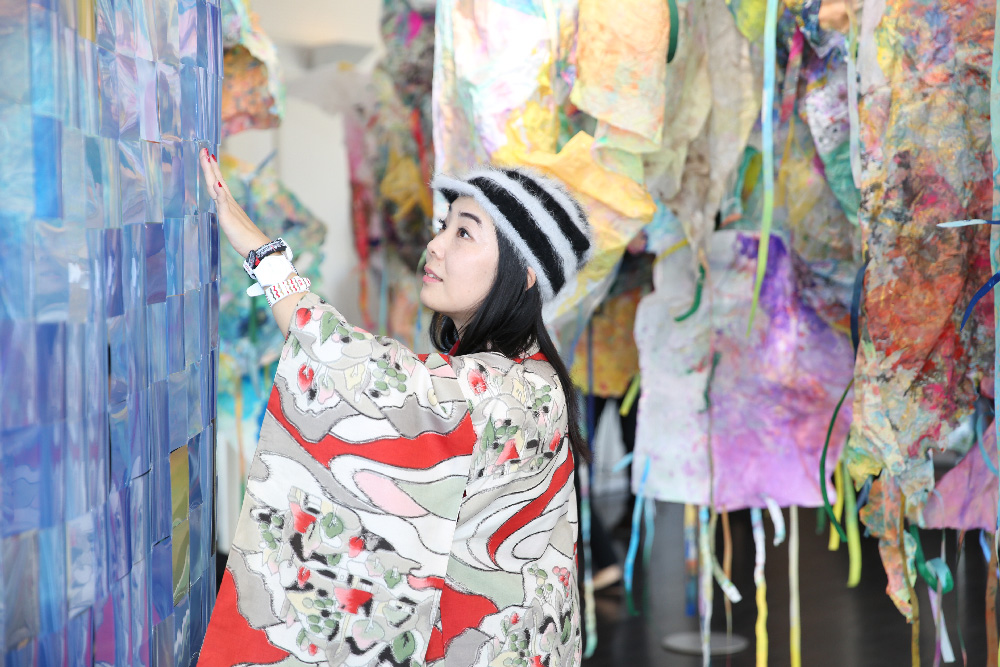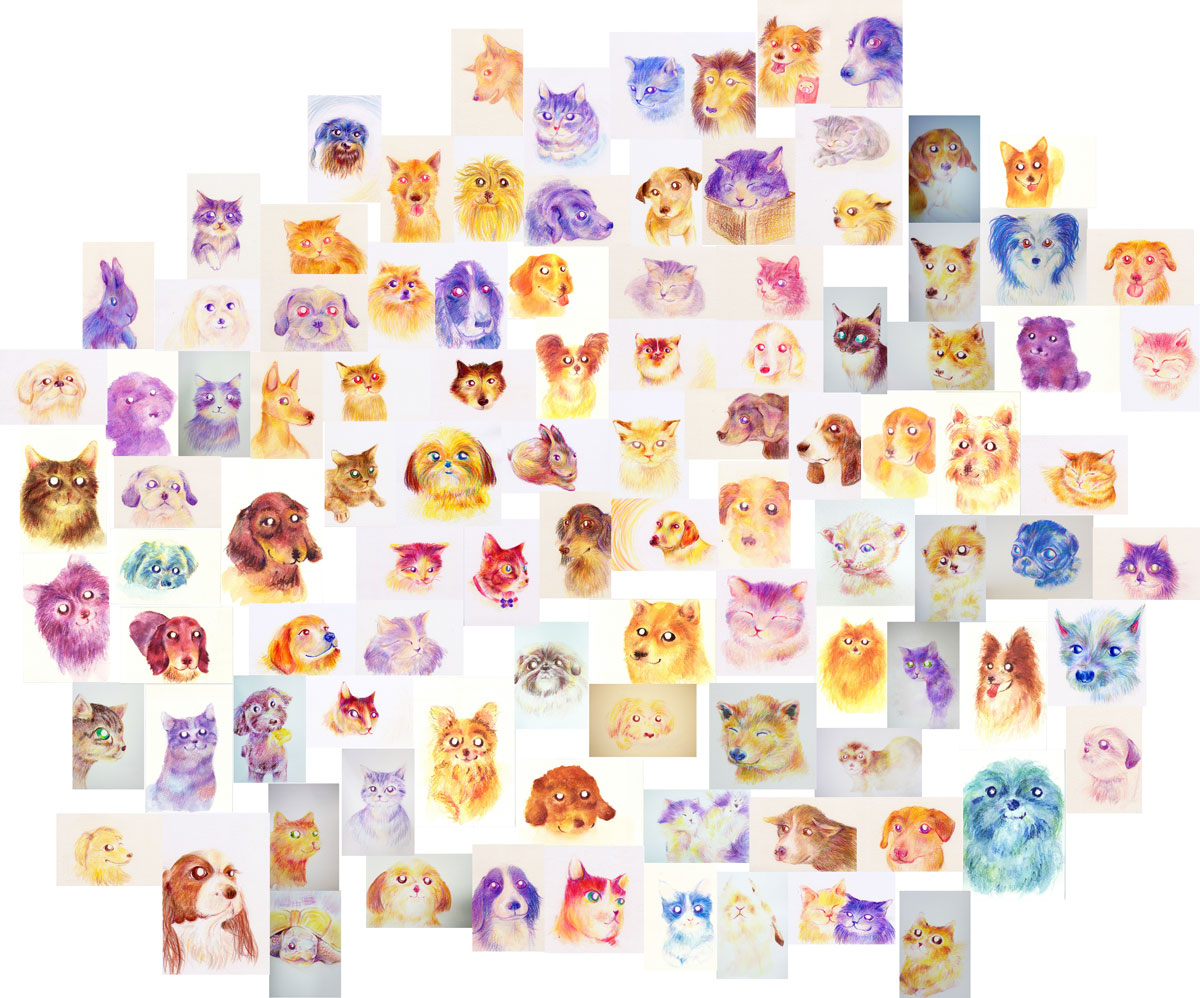Ouma / オーマ
Born in Tokyo, Japan. Ouma is a contemporary artist and former veterinarian. After Ouma’s animal patients passed away, Ouma began sending drawings of them to their families, and the number of such works has now exceeded one hundred. Since then, Ouma has pursued art to fulfill what she views as the essence of veterinary work: healing the human heart.
Japanese art critic Masaomi Unagami, owner of the gallery UNAC TOKYO, took an interest in Ouma’s practice. In 2013, Ouma held her first solo exhibition at UNAC TOKYO, covering the interior of the gallery with drawings. The show felt like traveling inside a body and offered viewers a unique experience. Ouma has since sought new definitions of life through artworks that involve viewers as co-creators, blurring the line between artist and audience.
Ouma’s major works include “Phylogenetic Tree,” an open-ended project in which small, cell-like pieces continually proliferate and disappear, forming a single monumental work, and “Life Continuous,” whose paper elements resemble cell membranes; viewers can enter, tear, and reattach them, generating ever-changing forms.
Since 2016, Ouma has participated in thirteen artist-in-residence programs across ten countries, including the Swatch Art Peace Hotel (Shanghai), the ACCR – Odyssee Artist-in-Residency Program (France), Danish Art Workshops (Denmark), and the Hongti Art Center (South Korea).
Since 2024, Ouma has been creating the “Strangers” series, which integrates AI and manga, and Ouma also serves as the chairperson of the art project “SORA.”
Ouma regards life as something that should be discussed across multiple layers—cells, individuals, societies, and beyond. While each layer requires its own therapeutic approach, Ouma believes the most effective strategies originate from more panoramic layers. Ouma’s concept of **“social therapy”** is a holistic approach that heals individuals together with their surrounding environments, and within today’s accelerating society Ouma advocates **“reversible death”** as a particularly potent method. By repeatedly undergoing reversible deaths—resetting skills, behaviors, and even cherished values—people can re-optimize themselves in relation to society and reboot as more resilient beings. Such reversible deaths naturally encompass environmental shifts through relocation. Through artworks that combine narrative and physical experience, Ouma aims to offer viewers the experience of reversible death as social therapy.
東京都出身、現代アーティスト・元獣医師。ある時から亡くなった子の絵を描いて家族に送るようになり、その数は100点以上に。小さな絵に感動していただけたことをきっかけに、アートを通じて獣医師の仕事の本質である「ヒトの心の癒し」が全うできる方法はないかと考え始める。2013年に美術批評家・海上雅臣氏主宰のギャラリー・ウナックトウキョウで行った、ギャラリーを画で覆う個展をきっかけにアート活動を本格化。体験と創造を鑑賞者と協働する創作者の不鮮明な作品を通じ、新しい生命の定義を模索してきた。
主な作品は、細胞のような小さな作品が増殖と喪失をつづけ、一つの巨大作品として成長し続けるオープンエンドプロジェクト「系統樹/Phylogenetic Tree」。複数の細胞膜のような紙作品を鑑賞者が破壊、結合することで不確実な形状を生み出し続ける「集合生命/Life Continuous」など。2016年よりSwatch Art Peace Hotel(上海)、ACCR - ODYSSEE ARTIST-IN-RESIDENCY PROGRAM 2018(フランス)、Danish Art Workshops(デンマーク)、Hongti Art Center(韓国)など世界10ヵ国13ヵ所のアーティスト・イン・レジデンスプログラムに参加。2024年からはAIとマンガを表現に取り入れた「見知らぬ人」シリーズを制作。アートプロジェクト「SORA」主宰。
Oumaは生命を細胞・個体・社会など複数のレイヤーで論じられるべきものと捉えている。
各レイヤーごとに適切な治療アプローチは異なるが、最も有効なのはより俯瞰したレイヤーからのアプローチではないだろうか。
「社会治療」という概念は、自己をその個人を取り巻く環境=社会にまで拡張し、社会含めて治療しようという俯瞰的治療アプローチであり、加速する社会の中で特に効果を発揮する手法として、Oumaは「可逆的な死」を提唱する。
自身のスキルや行動様式、時には大切な価値観さえも刷新する「可逆的死」を繰り返すことにより、私たちは自らを社会に対して最適化し、より耐性のついた存在として再起動することができる。社会治療としての「可逆的死」の中には、移動による環境変化・再配置も含む。
Oumaはアート作品を通じ、社会治療としての「可逆的な死」を人々に提供する。
韓国の美術批評家Lee Seon-yeongによる評論文「自然から学ぶ共存の技」はこちら

